ECO mode Acura TL 2002 3.2 Owner's Manual
[x] Cancel search | Manufacturer: ACURA, Model Year: 2002, Model line: TL, Model: Acura TL 2002Pages: 339, PDF Size: 4.71 MB
Page 9 of 339
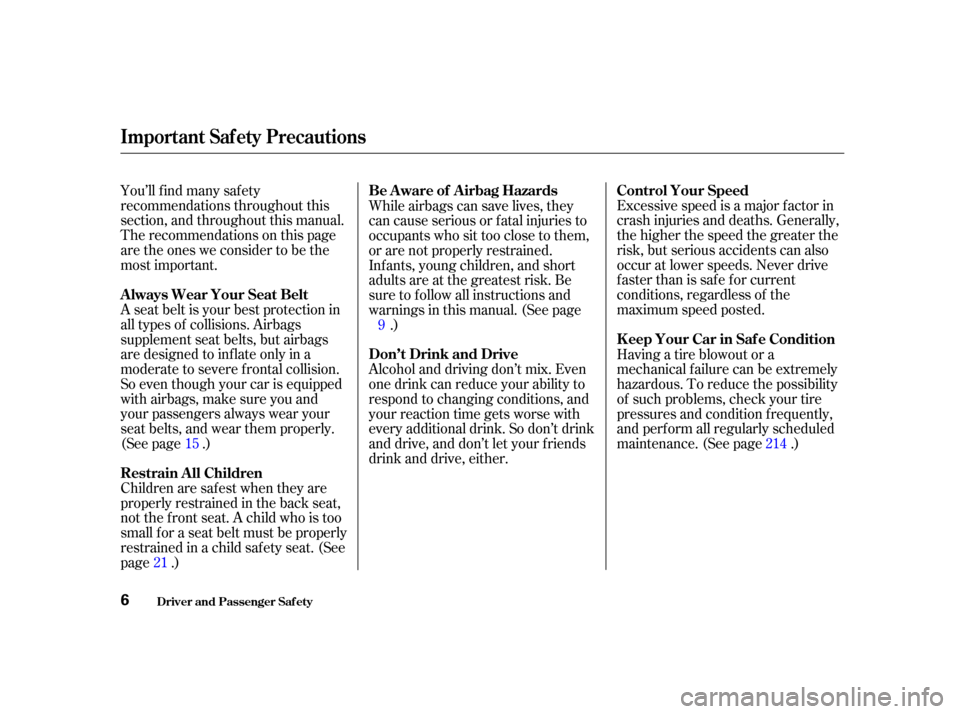
You’ll f ind many saf ety
recommendations throughout this
section, and throughout this manual.
Therecommendationsonthispage
are the ones we consider to be the
most important.Excessive speed is a major f actor in
crash injuries and deaths. Generally,
the higher the speed the greater the
risk, but serious accidents can also
occur at lower speeds. Never drive
f aster than is saf e f or current
conditions, regardless of the
maximum speed posted.
A seat belt is your best protection in
all types of collisions. Airbags
supplement seat belts, but airbags
are designed to inf late only in a
moderate to severe f rontal collision.
So even though your car is equipped
with airbags, make sure you and
your passengers always wear your
seat belts, and wear them properly.
(See page .)
Children are saf est when they are
properly restrained in the back seat,
notthefrontseat.Achildwhoistoo
smallforaseatbeltmustbeproperly
restrained in a child saf ety seat. (See
page .) Having a tire blowout or a
mechanical f ailure can be extremely
hazardous. To reduce the possibility
of such problems, check your tire
pressures and condition f requently,
and perform all regularly scheduled
maintenance. (See page .)
Alcohol and driving don’t mix. Even
one drink can reduce your ability to
respond to changing conditions, and
your reaction time gets worse with
every additional drink. So don’t drink
and drive, and don’t let your f riends
drink and drive, either. While airbags can save lives, they
can cause serious or fatal injuries to
occupants who sit too close to them,
or are not properly restrained.
Inf ants, young children, and short
adults are at the greatest risk. Be
sure to f ollow all instructions and
warnings in this manual. (See page
.)
9
15
21 214
Driver and Passenger Saf ety
Important Saf ety Precautions
Always Wear Your Seat Belt
Be Aware of Airbag Hazards Control Your Speed
K eep Your Car in Saf e Condition
Restrain All Children Don’t Drink and Drive
6
00/12/25 13:53:46 31S0K630_009
Page 25 of 339

Front airbags have been designed to
help protect adults in a moderate to
severe f rontal collision. To do this,
the passenger’s f ront airbag is quite
large, and it inf lates with tremendous
speed.
According to accident statistics,
children of all ages and sizes are
saf er when they are restrained in the
back seat, not the f ront seat. The
National Highway Traf f ic Saf ety
Administration and Transport
Canada recommend that all children
ages 12 and under be properly
restrained in the back seat.
In the back seat, children are less
likely to be injured by striking hard
interior parts during a collision or
hard braking. Also, children cannot
be injured by an inf lating airbag
when they ride in the back.
If you are not wearing a
seat belt in a crush, you could be
thrown f orward into the
dashboard and crush the child. If
youarewearingaseatbelt,the
child can be torn f rom your arms
during a crush. For example, if
your car crushes into a parked
vehicleat30mph(48km/h),a
20-lb (9 kg) inf ant will become a
600-lb (275 kg) f orce, and you will
not be able to hold on.
During a
crash, the belt could press deep
into the child and cause very
serious injuries. The Passenger’s Front Airbag
Poses Serious Risks to Children
Children Should Sit in the Back
Seat
Protecting Children
Driver and Passenger Saf ety
A ddit ional Precaut ions t o Parent s
Neverholdaninfantorchildonyour lap.
Never put a seat belt over yourselfand an inf ant or child.
22
00/12/25 13:56:32 31S0K630_025
Page 30 of 339
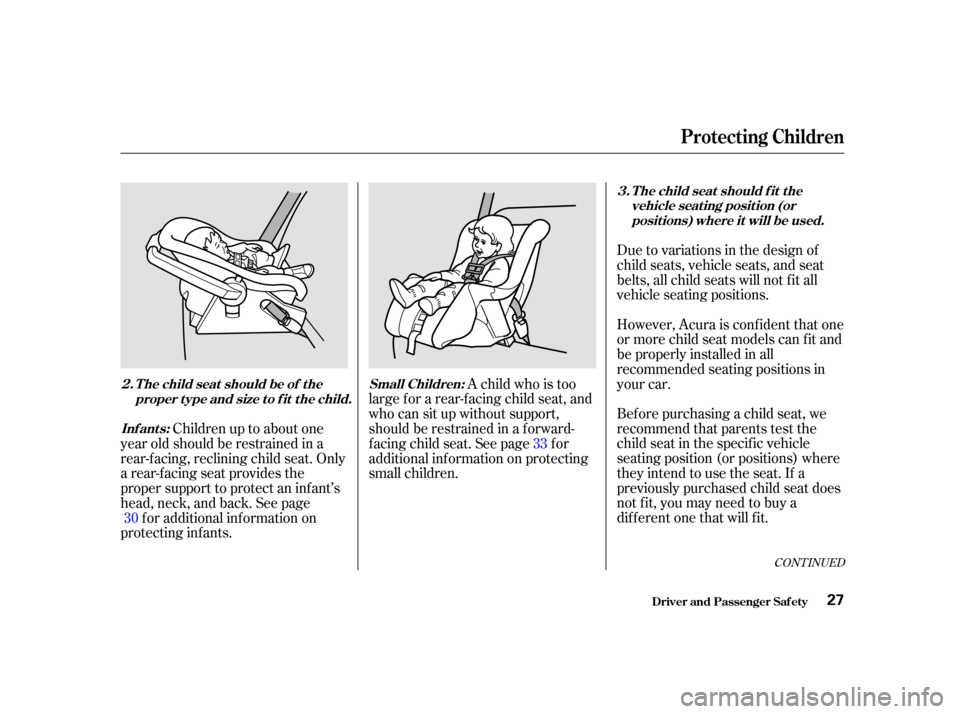
CONT INUED
Bef ore purchasing a child seat, we
recommend that parents test the
child seat in the specif ic vehicle
seating position (or positions) where
they intend to use the seat. If a
previously purchased child seat does
not f it, you may need to buy a
different one that will fit. However, Acura is conf ident that one
or more child seat models can f it and
be properly installed in all
recommended seating positions in
your car. Due to variations in the design of
child seats, vehicle seats, and seat
belts, all child seats will not f it all
vehicle seating positions.
A child who is too
large f or a rear-f acing child seat, and
who can sit up without support,
should be restrained in a f orward-
f acing child seat. See page f or
additional inf ormation on protecting
small children.
Childrenuptoaboutone
year old should be restrained in a
rear-f acing, reclining child seat. Only
a rear-f acing seat provides the
proper support to protect an inf ant’s
head, neck, and back. See page for additional information on
protecting inf ants. 30 33
Protecting Children
Driver and Passenger Saf ety
T he child seat should f it the
vehicle seat ing posit ion (orposit ions) where it will be used.
Small Children:
T he child seat should be of the
proper t ype and size t o f it t he child.
Inf ant s: 3.
2.
27
00/12/25 13:57:33 31S0K630_030
Page 33 of 339
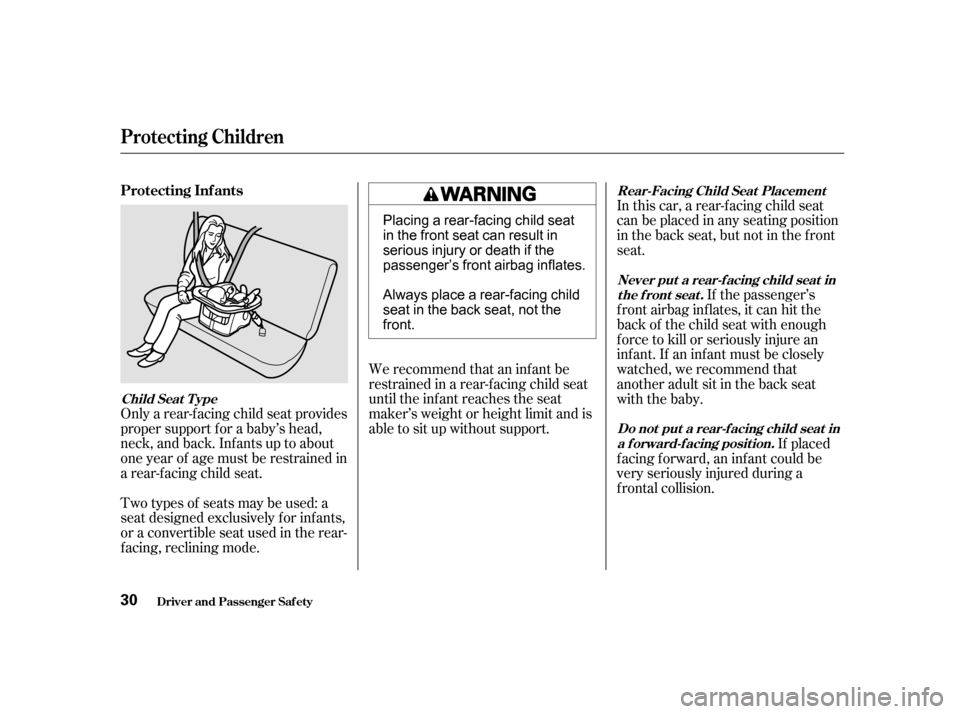
Only a rear-f acing child seat provides
proper support f or a baby’s head,
neck, and back. Inf ants up to about
one year of age must be restrained in
a rear-f acing child seat.In this car, a rear-f acing child seat
canbeplacedinanyseatingposition
in the back seat, but not in the f ront
seat.
We recommend that an inf ant be
restrained in a rear-f acing child seat
until the inf ant reaches the seat
maker’s weight or height limit and is
able to sit up without support.
Two types of seats may be used: a
seat designed exclusively f or inf ants,
or a convertible seat used in the rear-
f acing, reclining mode. If the passenger’s
f ront airbag inf lates, it can hit the
back of the child seat with enough
forcetokillorseriouslyinjurean
inf ant. If an inf ant must be closely
watched, we recommend that
another adult sit in the back seat
with the baby.
If placed
f acing f orward, an inf ant could be
very seriously injured during a
f rontal collision.
Protecting Inf ants
Child Seat T ype
Rear-Facing Child Seat Placement
Never put a rear-f acing child seat inthe front seat.
Do not put a rear-f acing child seat ina f orward-f acing position.
Protecting Children
Driver and Passenger Saf ety30
Placing a rear-facing child seat
in the front seat can result in
serious injury or death if the
passenger’s front airbag inflates.
Always place a rear-facing child
seat in the back seat, not the
front.
00/12/25 13:58:11 31S0K630_033
Page 50 of 339
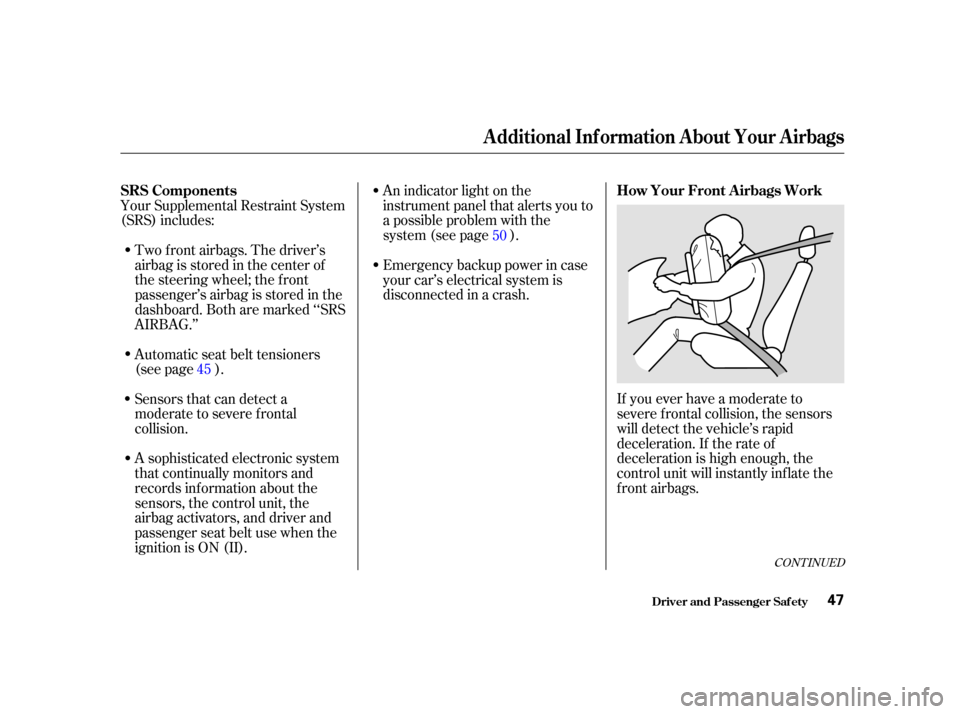
Your Supplemental Restraint System
(SRS) includes:An indicator light on the
instrument panel that alerts you to
a possible problem with the
system (see page ).
Two f ront airbags. The driver’s
airbag is stored in the center of
the steering wheel; the f ront
passenger’sairbagisstoredinthe
dashboard. Both are marked ‘‘SRS
AIRBAG.’’ Emergency backup power in case
your car’s electrical system is
disconnected in a crash.
If you ever have a moderate to
severe f rontal collision, the sensors
will detect the vehicle’s rapid
deceleration. If the rate of
deceleration is high enough, the
control unit will instantly inf late the
f ront airbags.
A sophisticated electronic system
that continually monitors and
records inf ormation about the
sensors, the control unit, the
airbag activators, and driver and
passenger seat belt use when the
ignition is ON (II). Sensors that can detect a
moderate to severe frontal
collision. Automatic seat belt tensioners
(see page ).
45 50
CONT INUED
SRS Components
How Your Front A irbags Work
Driver and Passenger Saf ety
Additional Inf ormation About Your Airbags
47
00/12/25 14:01:08 31S0K630_050
Page 57 of 339

These labels are in the locations
shown. They warn you of potential
hazards that could cause serious
injury. Read these labels caref ully.
If a label comes of f or becomes hard
to read, contact your Acura dealer
f or a replacement.
U.S. models onlyU.S. models
Canadian models
Saf ety L abels
Driver and Passenger Saf ety54
HOOD RADIATOR CAP
SUN VISOR
DASHBOARD
00/12/25 14:02:28 31S0K630_057
Page 64 of 339
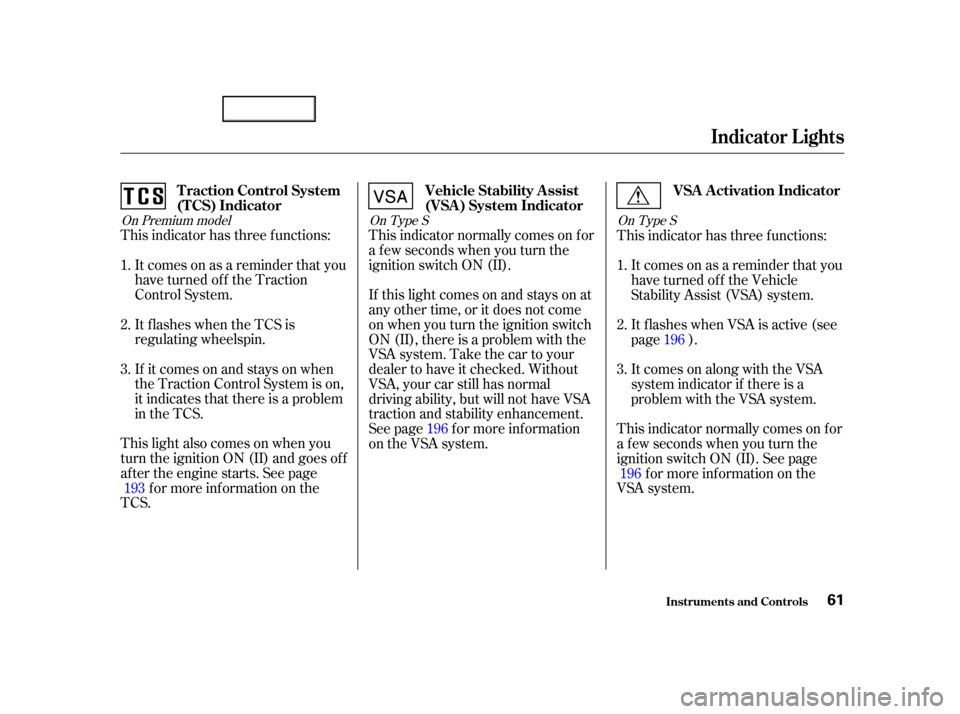
This indicator has three f unctions:Itcomesonasareminderthatyou
have turned off the Traction
Control System.
It f lashes when the TCS is
regulating wheelspin.
If itcomesonandstaysonwhen
the Traction Control System is on,
it indicates that there is a problem
in the TCS.
This light also comes on when you
turn the ignition ON (II) and goes off
af ter the engine starts. See page f or more inf ormation on the
TCS. This indicator normally comes on f or
a f ew seconds when you turn the
ignition switch ON (II).
If this light comes on and stays on at
any other time, or it does not come
on when you turn the ignition switch
ON (II), there is a problem with the
VSA system. Take the car to your
dealer to have it checked. Without
VSA, your car still has normal
driving ability, but will not have VSA
traction and stability enhancement.
See page f or more inf ormation
on the VSA system.
Itcomesonasareminderthatyou
have turned of f the Vehicle
Stability Assist (VSA) system.
It flashes when VSA is active (see
page ).
It comes on along with the VSA
system indicator if there is a
problem with the VSA system.
This indicator normally comes on f or
a f ew seconds when you turn the
ignition switch ON (II). See page f or more inf ormation on the
VSA system. This indicator has three f unctions:
1.
2.
3.
193 1.
2.
3.
196 196
196
On Type S On Type S
On Premium model
Traction Control System
(T CS) Indicator Vehicle Stability Assist
(VSA ) System IndicatorVSA A ctivation Indicator
Indicator L ights
Inst rument s and Cont rols61
00/12/25 14:03:40 31S0K630_064
Page 65 of 339
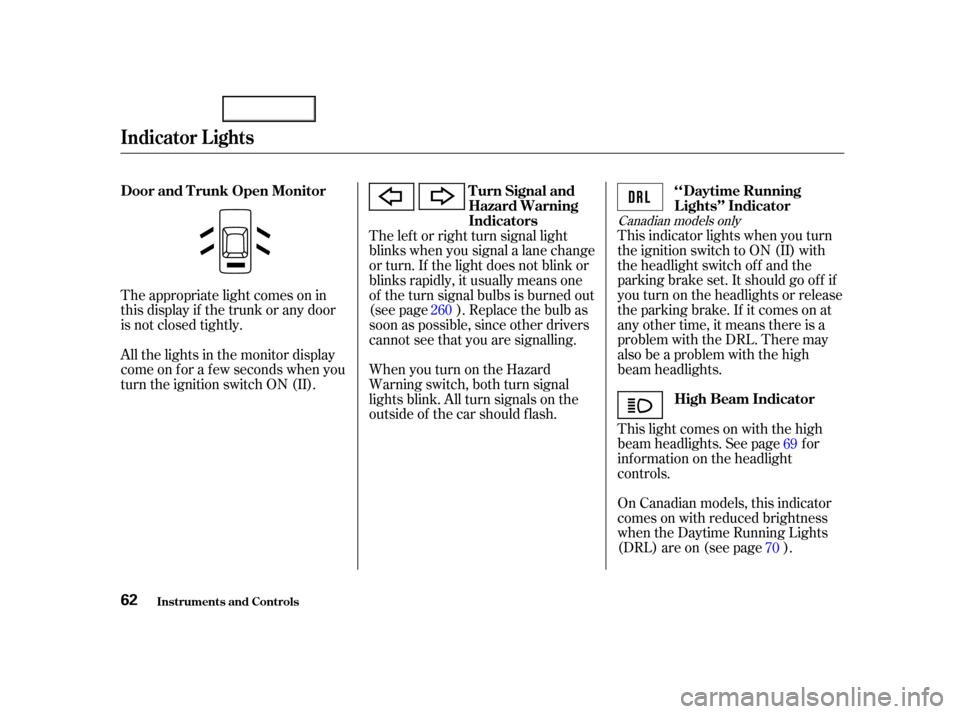
Canadian models only
This indicator lights when you turn
the ignition switch to ON (II) with
the headlight switch of f and the
parking brake set. It should go of f if
youturnontheheadlightsorrelease
the parking brake. If it comes on at
any other time, it means there is a
problem with the DRL. There may
also be a problem with the high
beam headlights.
This light comes on with the high
beam headlights. See page f or
inf ormation on the headlight
controls.
On Canadian models, this indicator
comes on with reduced brightness
when the Daytime Running Lights
(DRL) are on (see page ).
The lef t or right turn signal light
blinks when you signal a lane change
or turn. If the light does not blink or
blinks rapidly, it usually means one
of the turn signal bulbs is burned out
(see page ). Replace the bulb as
soon as possible, since other drivers
cannot see that you are signalling.
The appropriate light comes on in
this display if the trunk or any door
is not closed tightly.
WhenyouturnontheHazard
Warning switch, both turn signal
lights blink. All turn signals on the
outside of the car should f lash.
All the lights in the monitor display
come on f or a f ew seconds when you
turn the ignition switch ON (II). 260
69
70
Indicator L ights
Inst rument s and Cont rols
‘‘Daytime Running
Lights’’ Indicator
High Beam Indicator
Turn Signal and
Hazard Warning
Indicators
Door and T runk Open Monitor
62
00/12/25 14:03:53 31S0K630_065
Page 66 of 339
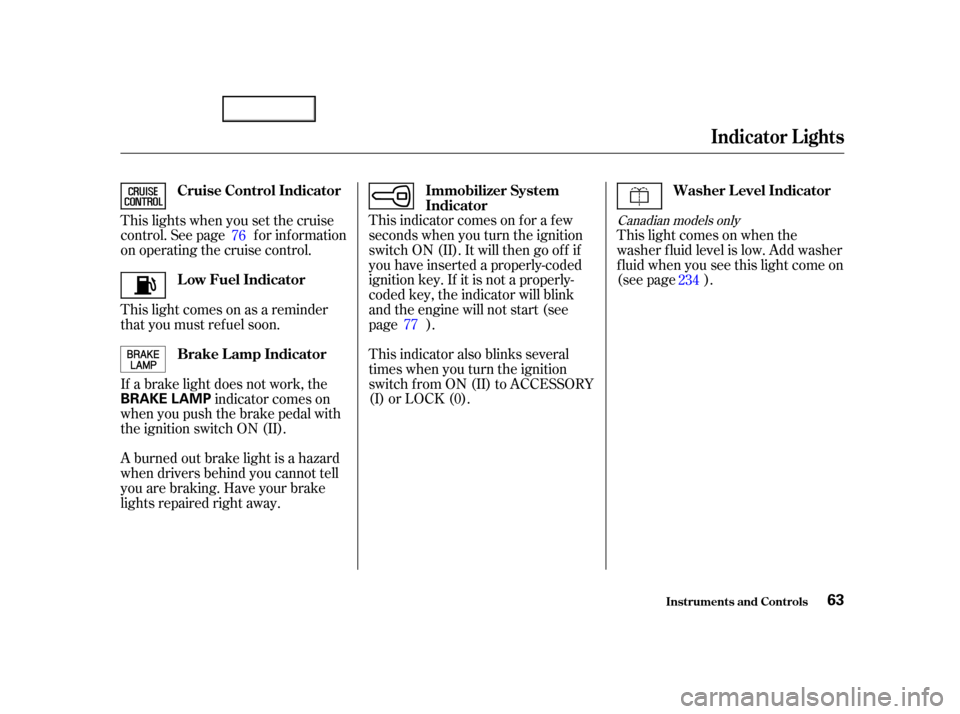
Canadian models only
This light comes on when the
washer f luid level is low. Add washer
f luid when you see this light come on
(see page ).
This indicator comes on f or a f ew
seconds when you turn the ignition
switch ON (II). It will then go of f if
you have inserted a properly-coded
ignition key. If it is not a properly-
coded key, the indicator will blink
and the engine will not start (see
page ).
This indicator also blinks several
times when you turn the ignition
switch f rom ON (II) to ACCESSORY
(I) or LOCK (0).
This lights when you set the cruise
control. See page f or inf ormation
on operating the cruise control.
This light comes on as a reminder
that you must ref uel soon.
If a brake light does not work, the
indicator comes on
when you push the brake pedal with
the ignition switch ON (II).
A burned out brake light is a hazard
when drivers behind you cannot tell
you are braking. Have your brake
lights repaired right away. 76
234
77
Indicator L ights
Inst rument s and Cont rols
Washer Level Indicator
Immobilizer System
Indicator
Cruise Control Indicator
Low Fuel Indicator
Brake L amp Indicator
63
BRAKE LAMP
00/12/25 14:04:09 31S0K630_066
Page 73 of 339
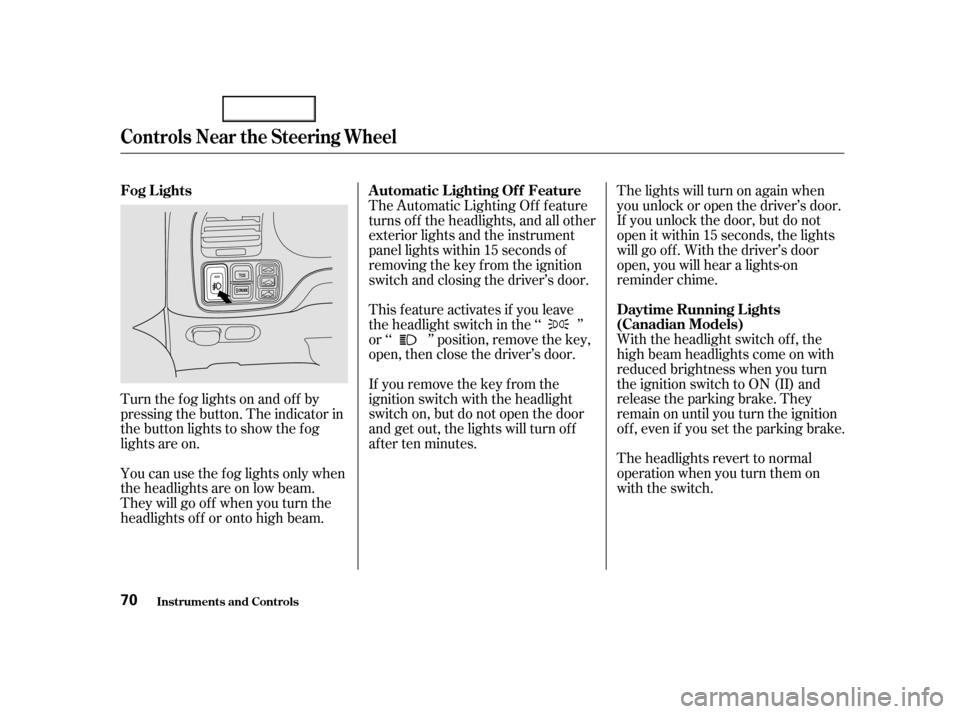
The lights will turn on again when
you unlock or open the driver’s door.
If you unlock the door, but do not
open it within 15 seconds, the lights
will go off. With the driver’s door
open, you will hear a lights-on
reminder chime.
With the headlight switch off, the
high beam headlights come on with
reduced brightness when you turn
the ignition switch to ON (II) and
release the parking brake. They
remain on until you turn the ignition
of f , even if you set the parking brake.
The headlights revert to normal
operation when you turn them on
with the switch.
The Automatic Lighting Of f f eature
turns of f the headlights, and all other
exterior lights and the instrument
panel lights within 15 seconds of
removing the key from the ignition
switch and closing the driver’s door.
This feature activates if you leave
the headlight switch in the ‘‘ ’’
or ‘‘ ’’ position, remove the key,
open, then close the driver’s door.
If you remove the key f rom the
ignition switch with the headlight
switch on, but do not open the door
and get out, the lights will turn of f
af ter ten minutes.
Turn the f og lights on and of f by
pressing the button. The indicator in
the button lights to show the f og
lights are on.
You can use the f og lights only when
the headlights are on low beam.
They will go of f when you turn the
headlights of f or onto high beam.
Controls Near the Steering Wheel
Inst rument s and Cont rols
Daytime Running L ights
(Canadian Models)
Automatic Lighting Of f Feature
Fog Lights
70
00/12/25 14:05:24 31S0K630_073